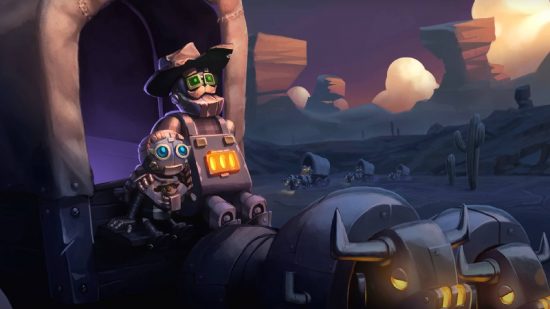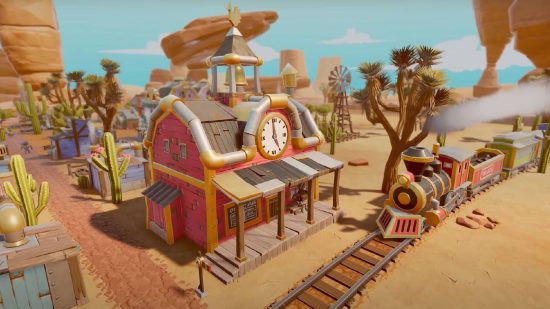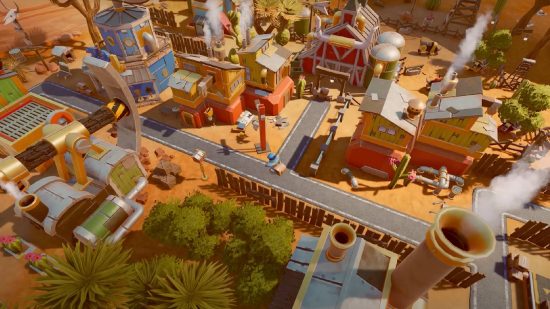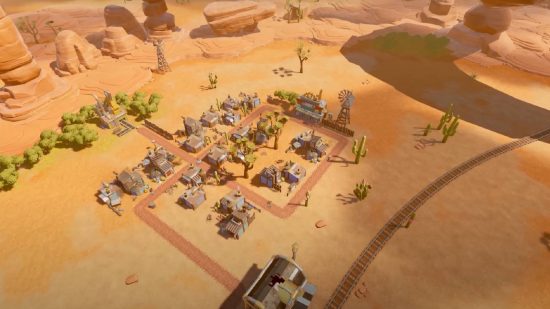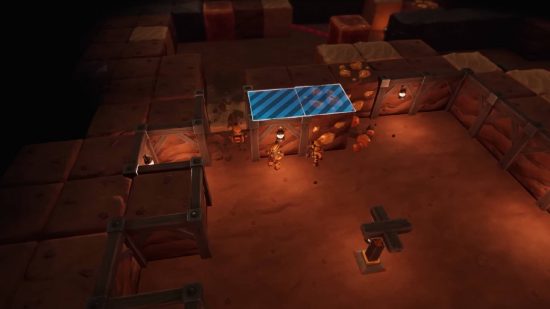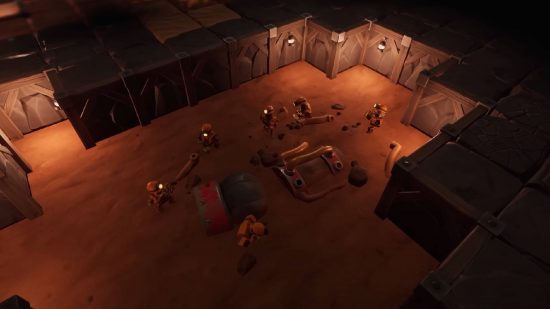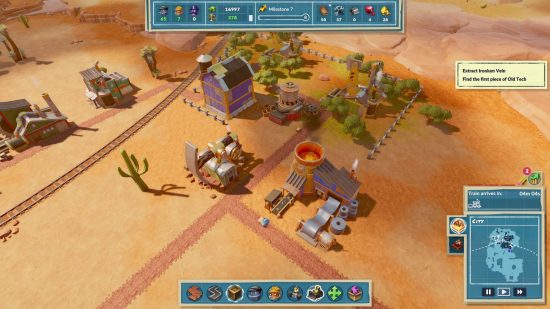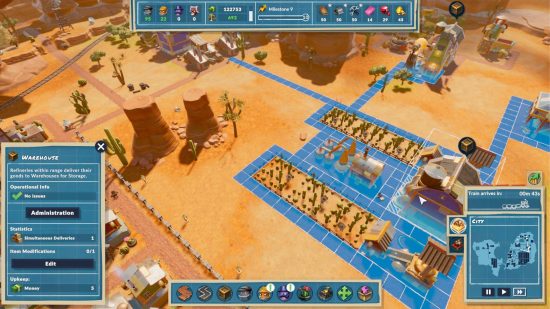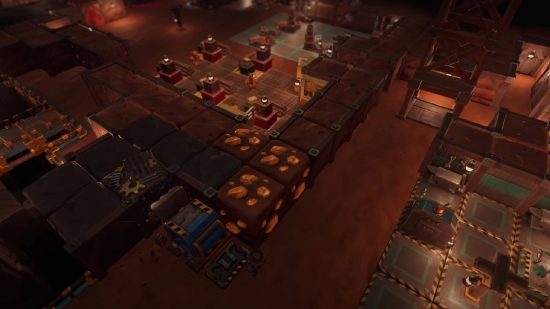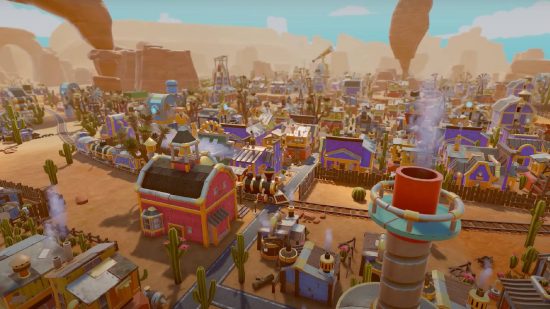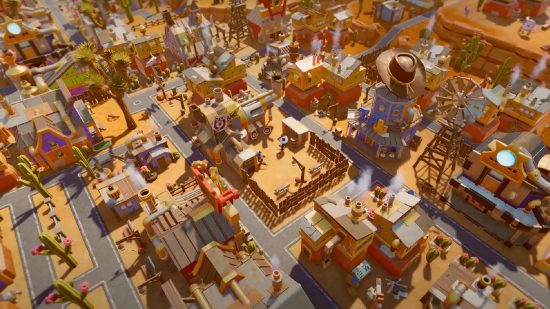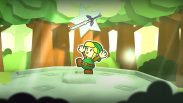It’s always exciting to see what’s next for the SteamWorld series, as our favourite franchise focusing on steampunk robots is responsible for several quality games. SteamWorld Dig 1 & 2, SteamWorld Heist, and the most recent release SteamWorld Quest all show the skill of the Thunderful Games devs (formerly Image & Form), as well as how malleable the series can be.
Well, it’s time for the next instalment, as SteamWorld Build heads to consoles and PC later this year, mixing up exciting city-building mechanics with mining gameplay in a mash-up the developers describe as “Anno meets Dungeon Keeper”. We’re busy playing the title’s demo ahead of its launch, which you should read all about in our SteamWorld Build preview. It’s fair to say that we’re having a blast managing our settlement and exploring the mines.
So, after the recent reveal of SteamWorld Build from Thunderful Games studio The Station, we’re interrogating producer Adam Vassée (he/him) and Thunderful CEO Brjánn Sigurgeirsson (he/him) about what this latest entry means for the franchise. Plus, how a city-building title fits into the franchise’s shared universe, what first-time fans of the genre can expect, and the challenge of taking over the SteamWorld stewardship from the talented Image & Form developers.
The studio Image & Form is responsible for the early SteamWorld games, though it merged with Zoink Games in 2019 to create Thunderful Games, a publisher and development house that produces the titles from the SteamWorld franchise and beyond. Based in Gothenburg, Sweden, Thunderful Games handles exciting titles like Wavetale, Paper Cut Mansion, Togges, and Lego Bricktales.
The most recent SteamWorld title, SteamWorld Quest, is from the brains of the now-defunct studio Image & Form. So, SteamWorld Build isn’t just the first Thunderful Games developed title, but The Station is the first developer outside of Image & Form to create an entry in the franchise
Speaking on creating a game in the beloved universe, Vassée explains that it “was an honour, we were big fans of the SteamWorld games already.” Eager fans needn’t worry about Image & Form passing on the baton. For one thing, Thunderful Games is hard at work on even more SteamWorld games. Meanwhile, The Station is also clearly coming from a place of reverence. Vassée tells us that when The Station learned it had the opportunity to work with the beloved IP, the team “knew that we were in for a treat.”
The Station is more than familiar with handling well-known franchises though, as the team is perhaps most famous for its work on the LittleBigPlanet franchise. Costumes in those games include odes to The Last of Us, God of War, and Uncharted, so Vassée tells us that The Station “[know] how important it is to maintain the essence of the original material.”
Luckily it seems The Station is working with the previous developer to maintain the quality and continuity of the series, while the team at Thunderful Games continues to put trust in the new SteamWorld stewards. Thunderful Games sound like a big happy family, as while The Station tinkers away on SteamWorld Build, Vassée explains that Image & Form is “there for us if ever we [need] support.”
While it must be daunting to take on a series with an established fanbase and pedigree for quality, The Station is also seemingly free to pave its own way. Vassée explains that the staff responsible for previous SteamWorld entries still put a lot of trust in The Sation to “take SteamWorld in a direction that would attract both old and hopefully new fans of the franchise.”
SteamWorld Build’s hook is the split duties of managing above-ground and underground in tandem. While the surface is home to a quirky city-builder with units going about their business, down in the mines you search for valuable resources for your factories and workers. Mining works on a grid, and where you place your units and pillars is essential to successful spelunking as well as to keep the mine from collapsing.
Being split into two types of gameplay is a fun quirk for the series and one that feels right at home, as Vassée tells us that “SteamWorld is and has always been about experimenting and exploring new things in the SteamWorld setting.” With a series almost as well known for its variety as for its quality, it’s heartening to see that the developer understands exactly why fans care about it so much, as Vassée claims the reason for the constant experimentation is “because it’s fun right?”
Importantly, the symbiotic relationship between the two elements is the heart of the game, and Vassée claims that this is a strong developmental focus. In fact, he goes on to explain that the balance of overground and underground is “absolutely the thing that we put most effort into.”
According to Vassée, The Station puts great importance on the idea “that you as a player [feel] like this is ONE game, and not two separate games squeezed into each other.” You move between the two gameplay elements at the touch of a button, making it simple and quick. Undoubtedly, this is thanks to The Station working hard to make it feel “fluid, smooth and just “right,” as Vassée explains
SteamWorld Build releases for consoles and PC later this year, and, ordinarily, city-building games feel more at home on PC. Keyboard and mouse controls suit a game with such minutia, but The Station is toiling away, ensuring eligibility and accessibility between every version of the game. This is something that the studio has a laser-focus on, and according to Vassée “there were a few choices we had to make early on.” For example, to focus on visibility, the team “had to make sure font sizes were eligible from afar, and that we didn’t add any UI functionality that wasn’t compatible with a controller.”
Many city-building and resource management games can be very UI heavy and easily overwhelm players, which is something The Station takes into consideration, as Vassée explains that “one of our main focuses was accessibility, we knew we had to simplify as much as possible.” In our time with the game, we commended SteamWorld Build’s commitment to clear objectives, markers, and tasks, so it certainly feels like the team’s work is paying off.
For fans of the SteamWorld franchise, there’s a surprisingly deep lore bubbling away behind the scenes that connect each entry. Vassée claims that Build fits neatly into this narrative, as“[the] story takes place parallel to the one in Dig 2.” Fans may remember that at the end of Dig 2, you see rockets leave the Earth, and according to Adam, “our story is about one of those rockets.” But that’s not all, as players get to know a loveable cast of new characters, though Vassée teases that “there might be some [characters] that you recognise as well.”
SteamWorld Dig 1 and 2 are possibly the most famous SteamWorld entries, 2D side-scrolling titles with a focus on mining with Metroidvania elements. With Build’s use of city-building and mining, you might wonder if The Studio ever thought of basing the mining gameplay on the type seen in the Dig titles. Well, according to Vassée, The Station “did look at having a 2D view of the mine early on but chose to go the 3D route instead.” It seems fans have to wait a while longer to get their next Dig fix.
There’s a good reason for this, however, as one of The Station’s biggest commitments is approachability. The split between the two gameplay elements is the reason for a more cohesive style, as Vassée explains that The Station is “worried that changing the way you played the game drastically would make it harder for the player to get into the game.” Considering how quickly and frequently players must swap between the two styles, it’s likely a wise decision to keep things as simple as possible.
With a growing range of genres under the SteamWorld umbrella, Build’s mixture of mechanics is its ace in the hole, something Vassée touches on as he says that “having different layers of gameplay is quite unique and something we put a lot of focus on.” Keeping fans busy whether they’re above or under the surface is a great way to satisfy players, a belief that The Station clearly shares, as Vassée claims that the studio is hard at work “making sure the mine feeds into the city and vice versa, forcing the player to make sure they don’t neglect any part of the game to make progress.”
One hurdle for many city-builders is an overwhelming amount of markers, objectives, or variable parts. In our sessions with SteamWorld Build, the title clearly explains and pinpoints each element, a great relief to anyone worrying about the mountain of tasks at hand. Vassée tells us that this is all by design, saying “we worked with the tutorial early on as we wanted the game to be playable throughout production, this meant also having a working tutorial at all times.”
For The Station, it’s clear that both the developer and player need to understand each element of the game, and the tutorial shows off this goal nicely. Vassée explains the work put into this, saying “The tutorial and UI we have today is the result of much iteration and playtesting.” There’s always the risk of players skipping the tutorial, plus elements after the opening hours must be just as clear, but again, The Station wants to make things as clear as possible.
Vassée goes into detail, explaining that The Station “worked a lot on improvements to the UX to make it easier for the player to both see the tutorial, such as adding animations and effects, but also making sure the UI was as easy to read as possible.” In tandem with the developer’s focus on simple and intuitive controls across all devices, we can’t wait to see how SteamWorld Build eventually shapes up on Nintendo Switch.
This focus on approachability is also likely music to the ears of many SteamWorld fans, as for many, this is their first experience with the city-building genre. Adam claims that fan feedback so far confirms this, as many SteamWorld fans are happy to jump in to try something new. The Station is currently busy making this an approachable title for newcomers, as Vassée explains “It is fine if the game is complex but it shouldn’t be complicated.”
So, fans jumping into the genre may find this a perfect place to start. Meanwhile, The Station is proud of the effort it’s pouring into the title and just how accessible it is. Vassée proclaims that “with the tutorial and guidance we have created together with the SteamWorld charm, I think many will realize that this is in fact a genre for them.”
CEO Brjánn Sigurgeirsson backs up this dedication to approachability, adding “one of the hallmarks of the SteamWorld games is that they present very tight gameplay in a very accessible way.” It’s a sentiment that rings true, as Steamworld Dig slowly introduce smart Metroidvania elements, Steamworld Heist is an XCOM-lite, and Quest is a great way to learn about deck-building RPGs. According to Sigurgeirsson, gamers can pick up a SteamWorld game in any genre and know “they’re about to be carefully introduced to – and guided through – the wonders of a new world of gaming.”
We can’t wait to see SteamWorld Build on Nintendo Switch later this year, and also to see the franchise branch out both in genres and developers. Fans may wonder where the space-faring series could go next, and just how many genres it can tackle, and the answer according to Sigurgeirsson is “exactly as many genres and genre mashups as there are, or as many as we can imagine! There are really no boundaries there.”
With a string of hits under its belt and a promising new title on the way, the future of the SteamWorld series looks bright. Who knows what other genres it could tackle next, but Sigurgeirsson jokes that anything is possible, including “SteamWorld Racing? SteamWorld Dating? SteamWorld Date Racing? I guess we’ll find out!” He might be joking, but SteamWorld Date Racing sounds pretty great if you ask us.

The SteamWorld Build release date is set for later this year, as the title heads to Nintendo Switch, PS4/PS5, Xbox consoles, and PC later on in 2023.
